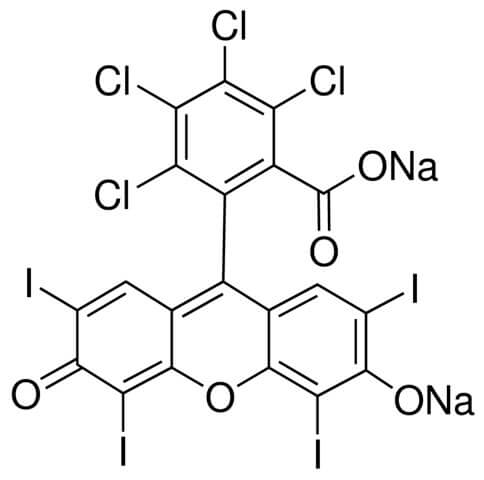
Rose Bengal is a red or rose color dye and is anionic in nature. It is a 4,5,6,7-tetrachloro 2′,4′,5′,7′-tetraiodo derivative of fluorescein. It is widely used to detect damage to the ocular surface epithelium in ocular surface diseases such as dry eye and herpetic keratitis. Rose Bengal has mild antiviral potency. Rose Bengal is used to stain dead and degenerating cells and mucus. Rose Bengal has been used to evaluate acrosome integrity. It has also been used to initiate photothrombotic occlusion in blood.
| Molecular Weight | 997.66 |
| Formula | C20H5Cl4I4NaO5 |
| CAS Number | 632-69-9 |
| Solubility (25°C) | Water 30 mg/mL |
| Storage | 4°C, protect from light, dry, sealed |
| Species | Mouse | Rat | Rabbit | Guinea pig | Hamster | Dog |
| Weight (kg) | 0.02 | 0.15 | 1.8 | 0.4 | 0.08 | 10 |
| Body Surface Area (m2) | 0.007 | 0.025 | 0.15 | 0.05 | 0.02 | 0.5 |
| Km factor | 3 | 6 | 12 | 8 | 5 | 20 |
| Animal A (mg/kg) = Animal B (mg/kg) multiplied by | Animal B Km |
| Animal A Km |
For example, to modify the dose of Compound A used for a mouse (20 mg/kg) to a dose based on the BSA for a rat, multiply 20 mg/kg by the Km factor for a mouse and then divide by the Km factor for a rat. This calculation results in a rat equivalent dose for Compound A of 10 mg/kg.
[3] Juan Murube. Ocul Surf. Rose bengal: the second most commonly used surfocular vital stain
[4] M I Roat, et al. Arch Ophthalmol. The antiviral effects of rose bengal and fluorescein
| Related Fluorescent Dye Products |
|---|
| SOSG
SOSG (Singlet Oxygen Sensor Green Fluorescent Probe) is highly selective for singlet oxygen (1O2). It is commonly used for the detection of singlet oxygen in solutions and the evaluation of the efficacy of free radical scavengers. |
| FM1-43
FM1-43 is a very lipophilic, water-soluble styrene dyes, can specifically bind to cell membranes and inner membrane organelles to produce fluorescence. FM1-43 is widely used in endocytic and exospic membrane structure markers. |
| BCIP
BCIP is a chromogenic substrate for colorimetric assay of alkaline phosphatase activity. |
| MCA-SEVNLDAEFR-K(Dnp)-RR, amide
MCA-SEVNLDAEFR-K(Dnp)-RR, amide is a FRET-based substrate. |
| MeOSuc-AAPV-AMC
MeOSuc-AAPV-AMC is a fluorogenic substrate for human leukocyte and porcine pancreatic elastase (Km: 362 μM, Ex=380 nm, Em=460 nm). |


Products are for research use only. Not for human use. We do not sell to patients.
© Copyright 2010-2023 AbMole BioScience. All Rights Reserved.
